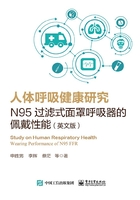
1.3 Outline
This book is divided into 12 chapters.Chapter 2 studies the filtration performance,i.e.,pressure drop and filtration efficiency,of different types of multi-fiber filters by using the CFD method.Chapter 3 investigates the dynamic performance of particle rebound and statistically analyses the deposition/accumulation of particles on a fiber surface.
Chapter 4 describes the construction of the upper respiratory airway,headform and FFR.The CFD method is used to simulate the flow field in the upper respiratory airway when wearing the N95 FFR.Chapter 5 studies the distribution characteristics of water vapor condensation on the inner surface of the FFR under different breathing conditions,including different environmental temperatures and breathing patterns.Chapter 6 studies micro-climate features in the deadspace of an N95 FFR considering water vapor condensation.It simulated the temperature and water distribution in the deadspace of N95 FFR using the computational fluid dynamics method.Then,it experimentally measured the temperature,relative humidity and bacteria distribution inside N95 FFR.Chapter 7 quantitatively investigates the flow characteristics and respiratory deposition of particles.A computational fluid dynamic method was used to assess the velocity,concentration and inhalation levels of indoor particles using a mankind realistic upper respiratory tract.An experiment is also performed to measure the PM2.5 concentrations.
Chapter 8 describes CFD simulation and validation of an improved FFR to enhance comfort of wearers during low-moderate activity.Chapter 9 presents a new FFR with an intelligent control fan which has better comfort and permeability.A fan with intelligent control can reduce the temperature and humidity and CO2 concentration.Compared with the FFR with a ventilation fan proposed in Chapter 5,the advantage of the new FFR is the ability to control the rotation of the fan intelligently with the change of the FFR chamber temperature and humidity,including the opening,closing and speed of the fan.
Chapter 10 describes the process of wearing a respirator on a static headform.The contact characteristics are investigated.Chapter 11 studies the effects of four typical facial expressions (calmness,happiness,sadness and surprise) on the contact characteristics between the respirator and headform.The respirator comfort and fit are discussed in the two chapters.
Chapter 12 proposes a novel technology to produce customized face seal design for improving the wearing comfort and fit of FFR wearers.